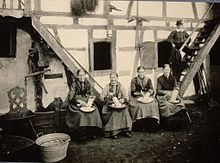Engwiller
| Engwiller | ||
|---|---|---|

|
|
|
| region | Grand Est | |
| Department | Bas-Rhin | |
| Arrondissement | Haguenau-Wissembourg | |
| Canton | Reichshoffen | |
| Community association | Haguenau | |
| Coordinates | 48 ° 53 ' N , 7 ° 37' E | |
| height | 187-271 m | |
| surface | 3.74 km 2 | |
| Residents | 501 (January 1, 2017) | |
| Population density | 134 inhabitants / km 2 | |
| Post Code | 67350 | |
| INSEE code | 67123 | |
 Engwiller |
||
Engwiller ( German : Engweiler ) is a French commune with 501 inhabitants (as of January 1, 2017) in the Bas-Rhin department in the Grand Est region (until 2015 Alsace ).
geography
Engwiller is a clustered village . A side street serves as the Rue Principale (main street). The municipality is partly forested.
history
middle Ages
The Lichtenberg dominion bought the village of Engweiler in the middle of the 14th century: in 1350 first rights from Diemar Bogener von Hagenau, in 1355 the village is finally near Lichtenberg. It was a fiefdom of the Murbach abbey . Due to the acquisition of territory in the 14th century, the Ingweiler and Buchsweiler authorities, which had become too extensive, had to be reorganized at the beginning of the 15th century . Among other things, the Pfaffenhofen office was spun off and made independent, to which Engweiler also belonged.
Anna von Lichtenberg (* 1442; † 1474), one of the two heirlooms of Ludwig V von Lichtenberg (* 1417; † 1474) married Count Philip I the Elder of Hanau-Babenhausen (* 1417; † 1480), one of them had received a small secondary school from the inventory of the County of Hanau in order to be able to get married. The county of Hanau-Lichtenberg came into being through the marriage. After the death of the last Lichtenberger, Jakob von Lichtenberg , an uncle of Anna, Philipp I. d. Ä. 1480 half of the Lichtenberg rule . The Pfaffenhofen office with Engweiler also belonged to this half.
Modern times
Count Philip IV of Hanau-Lichtenberg (1514–1590), after taking office in 1538, consistently carried out the Reformation in his county, which now became Lutheran .
As a result of France's reunion policy in 1680, considerable parts of the County of Hanau-Lichtenberg in Alsace fell under the sovereignty of France . This also included the Pfaffenhofen Office.
1736 died with Count Johann Reinhard III. the last male representative of the Hanau family. Then the village came to the Nassau-Ottweiler .
Population development
| 1962 | 1968 | 1975 | 1982 | 1990 | 1999 | 2006 | 2017 |
|---|---|---|---|---|---|---|---|
| 365 | 384 | 414 | 406 | 443 | 432 | 450 | 501 |
economy
Agriculture and small businesses are important branches of industry .
literature
- Fritz Eyer: The territory of the Lords of Lichtenberg 1202-1480. Investigations into the property, the rule and the politics of domestic power of a noble family from the Upper Rhine . In: Writings of the Erwin von Steinbach Foundation . 2nd edition, unchanged in the text, by an introduction extended reprint of the Strasbourg edition, Rhenus-Verlag, 1938. Volume 10 . Pfaehler, Bad Neustadt an der Saale 1985, ISBN 3-922923-31-3 (268 pages).
- Alfred Matt: Bailliages, prévôté et fiefs ayant fait partie de la Seigneurie de Lichtenberg, du Comté de Hanau-Lichtenberg, du Landgraviat de Hesse-Darmstadt . In: Société d'Histoire et d'Archaeologie de Saverne et Environs (Eds.): Cinquième centenaire de la création du Comté de Hanau-Lichtenberg 1480 - 1980 = Pays d'Alsace 111/112 (2, 3/1980), p 7-9.
- Le Patrimoine des Communes du Bas-Rhin . Flohic Editions, Volume 2, Charenton-le-Pont 1999, ISBN 2-84234-055-8 , pp. 869-870.

